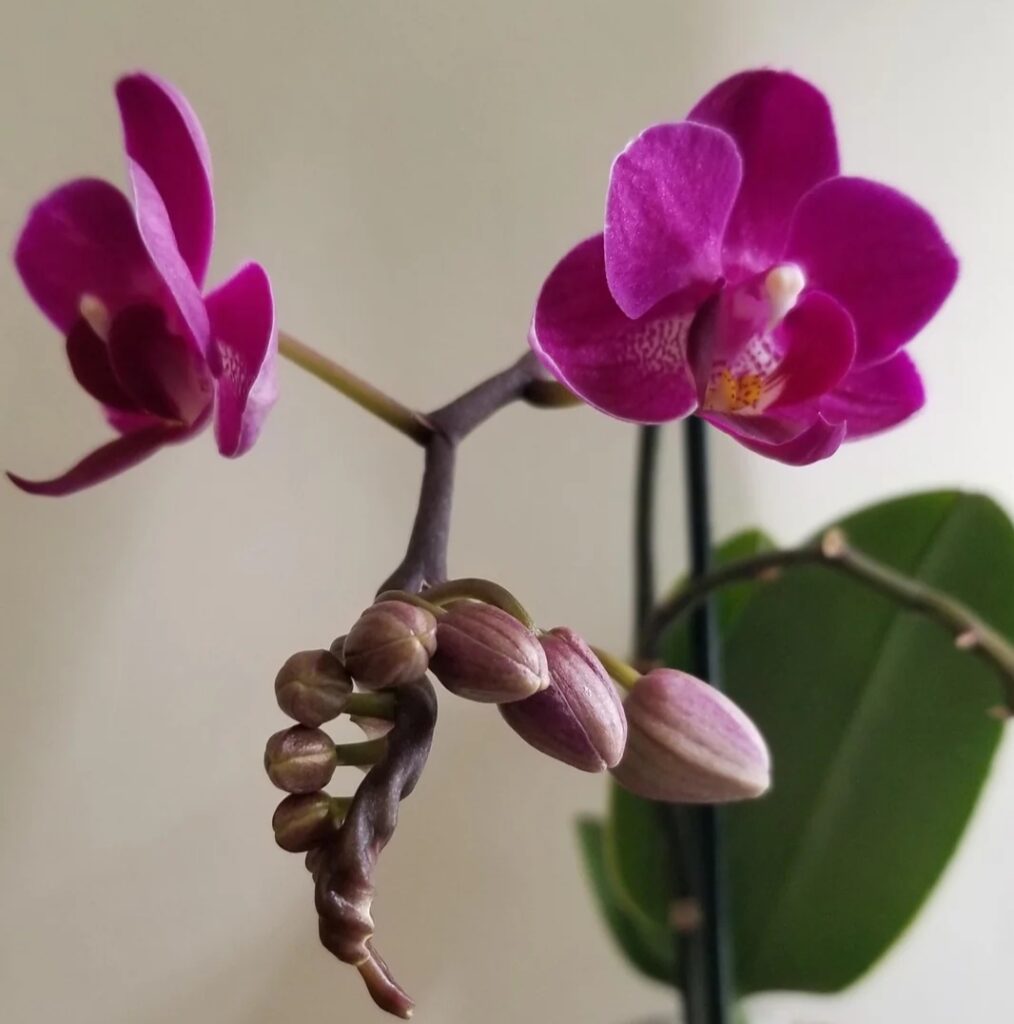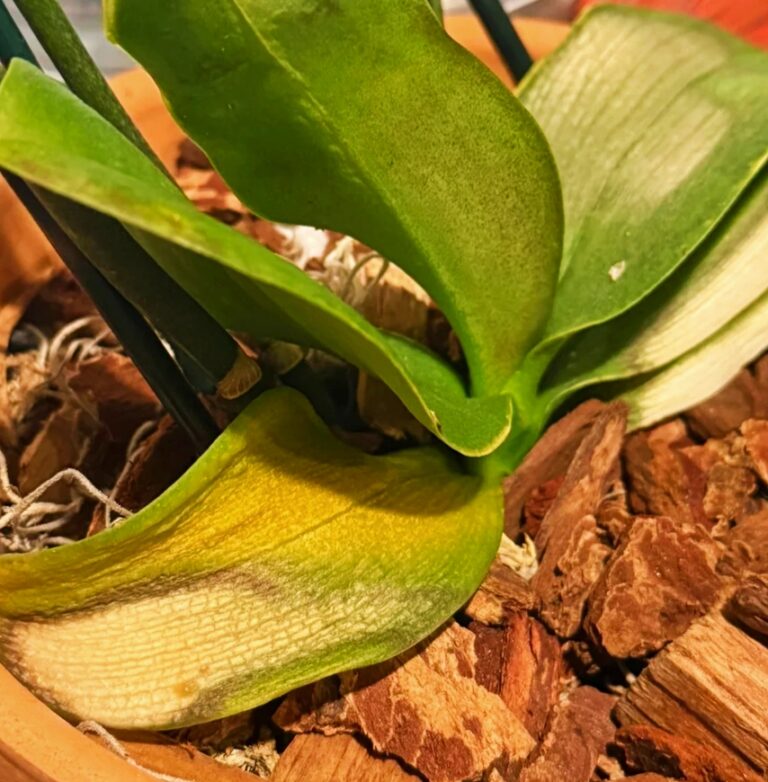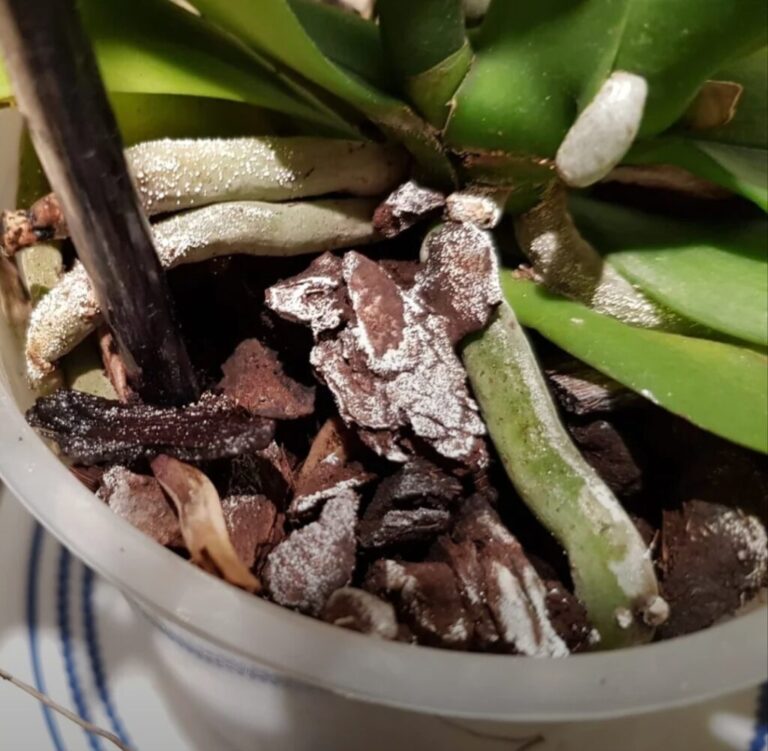Orchids are elegant and exotic plants that can elevate any space, but when their vibrant blooms or glossy leaves start to fade, it’s a sign something’s wrong. Is your orchid sick? Don’t panic—many common orchid diseases are treatable if caught early. In this guide, we’ll cover the top 10 orchid diseases, how to identify them, and most importantly, how to cure them effectively.
If you’ve noticed mysterious spots on the leaves, drooping flowers, or roots turning mushy, your orchid might be dealing with a hidden health issue. Orchids are prized for their beauty, but they are also sensitive and vulnerable to various diseases that can sneak in undetected. Whether you’re a beginner or an experienced grower, recognizing the early warning signs can make the difference between saving your plant and losing it entirely.
In this post, we’ll dive into 10 shocking orchid diseases that could be damaging your plant right now—and exactly how you can cure them. From bacterial infections and fungal attacks to viral threats, this guide will help you diagnose each problem accurately. You’ll learn the causes, symptoms, and step-by-step solutions for each issue.
From the dreaded root rot to unusual leaf deformities, some orchid diseases spread fast and can even affect nearby plants. Early detection and proper treatment are key. Whether you’re caring for Phalaenopsis, Dendrobium, or Cattleya, understanding these diseases will empower you to protect your orchids like a pro.
By the end of this article, you’ll be armed with expert tips and proven remedies to bring your orchids back to full health. Let’s jump into the top 10 orchid diseases—and discover how to stop them in their tracks.
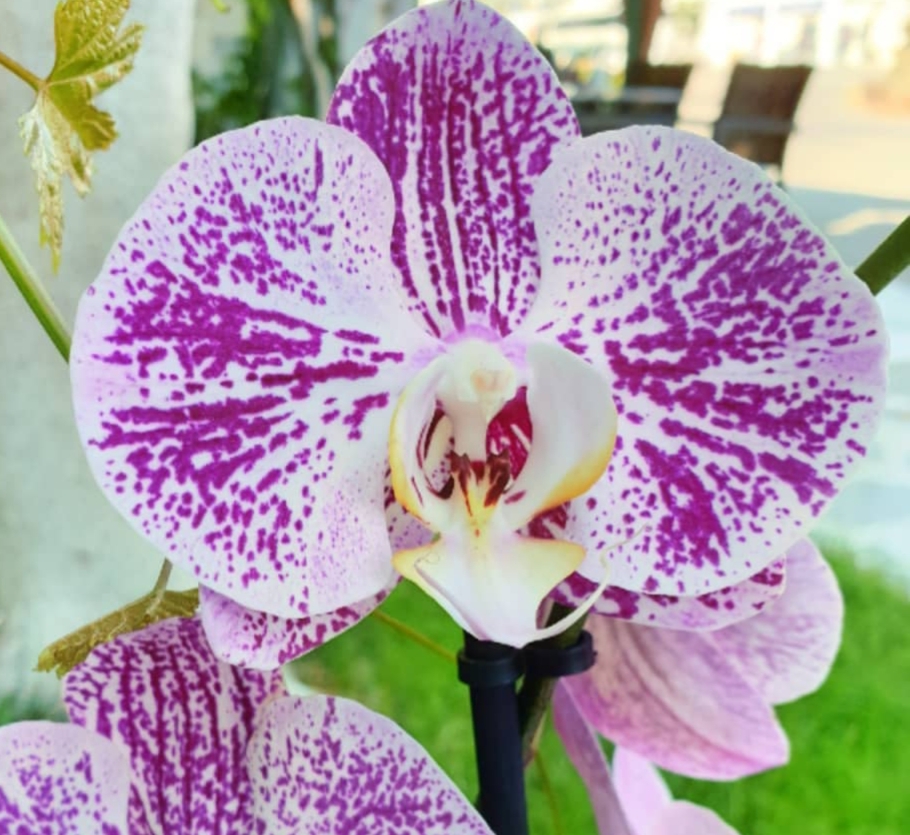
- 1 Why Are My Orchid Leaves Turning Yellow?
- 2 What Are the Black Spots on My Orchid?
- 3 Why Are My Orchid’s Flowers Deformed?
- 4 What’s Causing My Orchid’s Leaves to Pucker or Wrinkle?
- 5 Why Do My Orchid’s Leaves Have Silvery Webbing?
- 6 What Are These Sticky Drops on My Orchid?
- 7 Why Are My Orchid’s Buds Dropping Prematurely?
- 8 What’s Causing Brown Spots on My Orchid Leaves?
- 9 Why Are There White Fluffy Patches on My Orchid?
- 10 What’s This Mushy Brown Area at the Base of My Orchid?
- 11 FAQs – Is Your Orchid Sick
Why Are My Orchid Leaves Turning Yellow?

Disease: Root Rot ( leaves turning yellow)
Cause: Overwatering or poor drainage
Cure:
Yellowing leaves are a classic sign of root rot, which occurs when roots stay wet for too long and start to decompose. To save your orchid, remove it from its pot, trim all soft or blackened roots, and repot using a fast-draining orchid mix. Water only when the medium is nearly dry, and make sure your pot has proper drainage holes.
What Are the Black Spots on My Orchid?
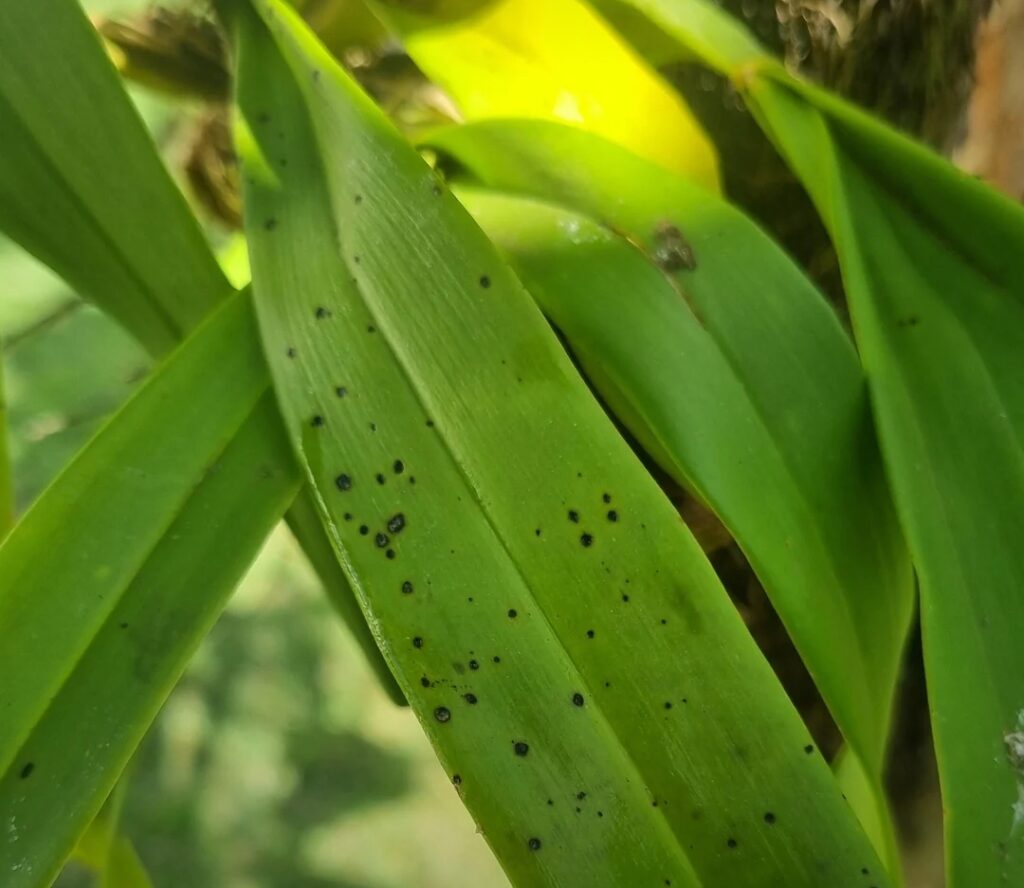
Disease: Black Rot (Pythium or Phytophthora)
Cause: Fungal infection due to excess moisture
Cure:
Black rot causes dark, mushy spots that spread rapidly, especially in warm, humid conditions. Start treatment by isolating the infected orchid to protect others.Using sterilised scissors, cut off all of the rotting tissue and dispose of it. Apply a broad-spectrum fungicide to the healthy parts and improve air circulation. Always avoid letting water sit on leaves or in crevices.
Why Are My Orchid’s Flowers Deformed?
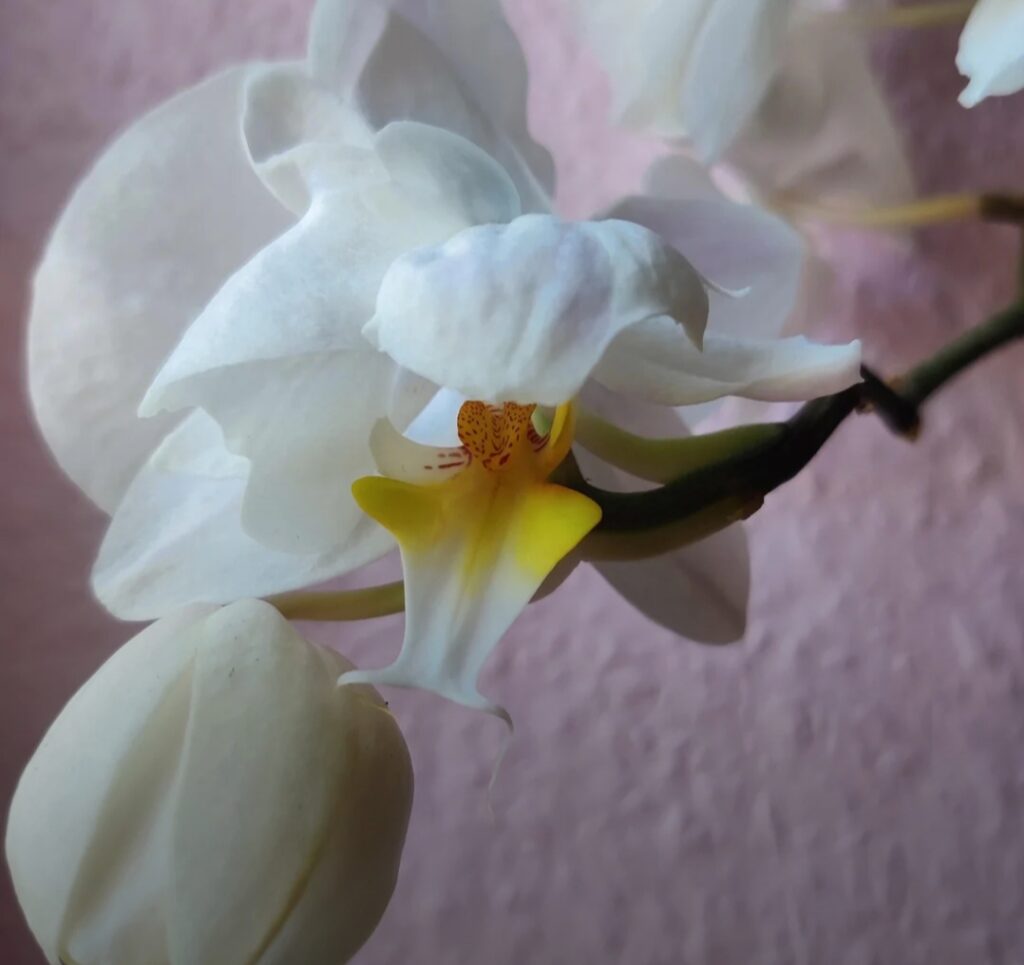
Disease: Orchid Viruses (e.g., Cymbidium Mosaic Virus)
Cause: Spread through contaminated tools or pests
Cure:
Distorted flowers with streaks or discoloration could indicate a virus. Orchid viral infections are unfortunately incurable. The best approach is prevention—sanitize your tools, isolate new plants, and avoid handling multiple orchids without cleaning in between. If you confirm a viral infection, it’s best to discard the plant to protect your entire collection.
What’s Causing My Orchid’s Leaves to Pucker or Wrinkle?
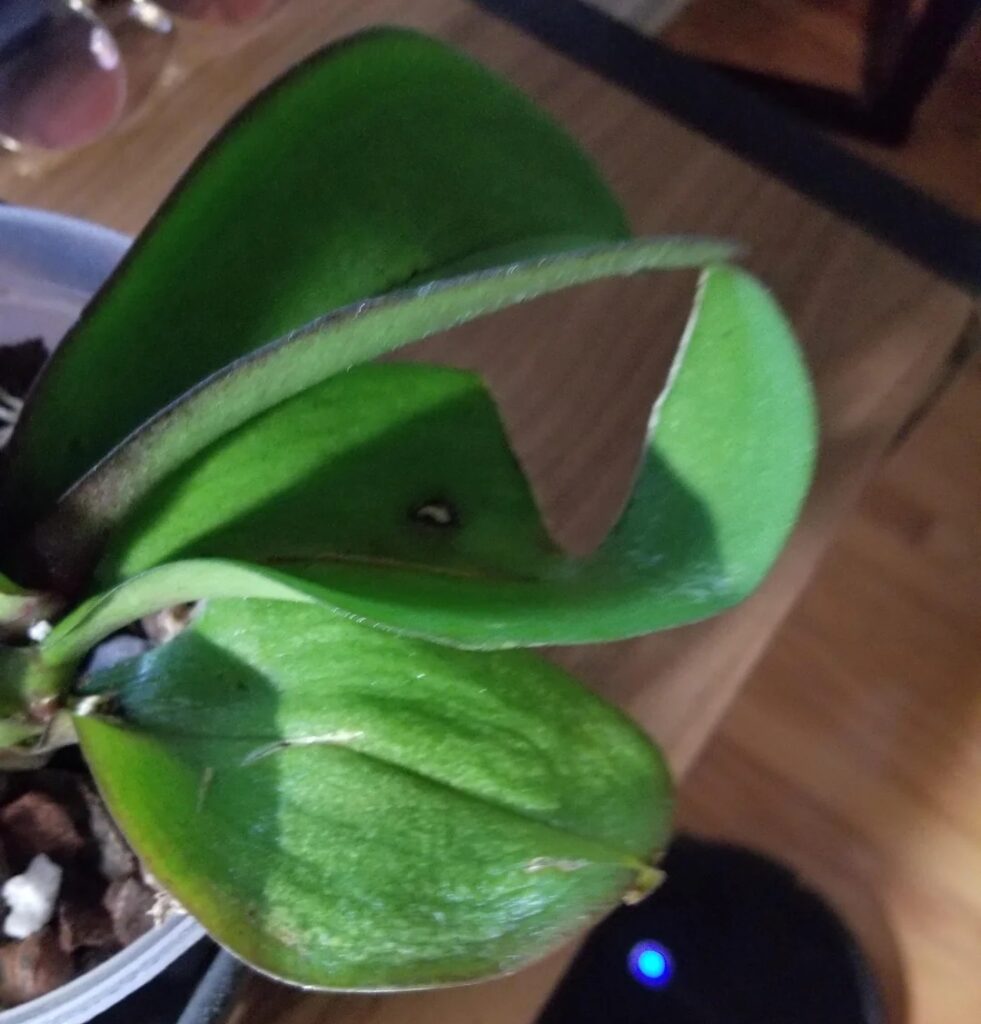
Disease: Dehydration or Root Damage
Cause: Poor watering or root rot affecting water absorption
Cure:
Wrinkled leaves are a sign that your orchid isn’t taking up water properly, often due to damaged roots. Examine the roots of the plant after carefully removing it from its pot.. Cut away anything that feels soft or mushy. After repotting, soak the plant in water for 30 minutes and increase ambient humidity by misting lightly or placing a tray of water nearby.
Why Do My Orchid’s Leaves Have Silvery Webbing?
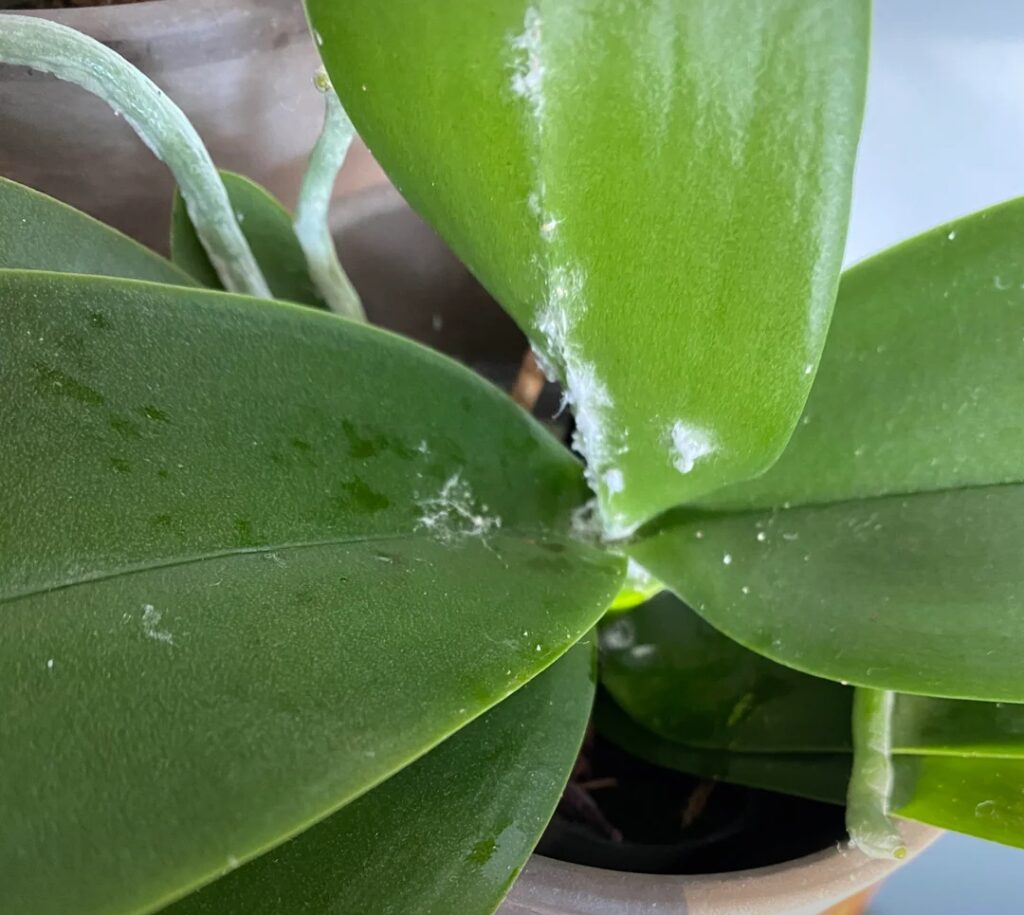
Disease: Spider Mites
Cause: Dry indoor air and poor airflow
Cure:
Tiny spider mites feed on leaf sap and leave behind silvery webs. While they’re hard to see, their damage is obvious. Begin treatment by wiping down leaves with a damp cloth. Spray neem oil or insecticidal soap every few days for at least two weeks. Increasing humidity and keeping plants dust-free will help prevent future infestations.
What Are These Sticky Drops on My Orchid?
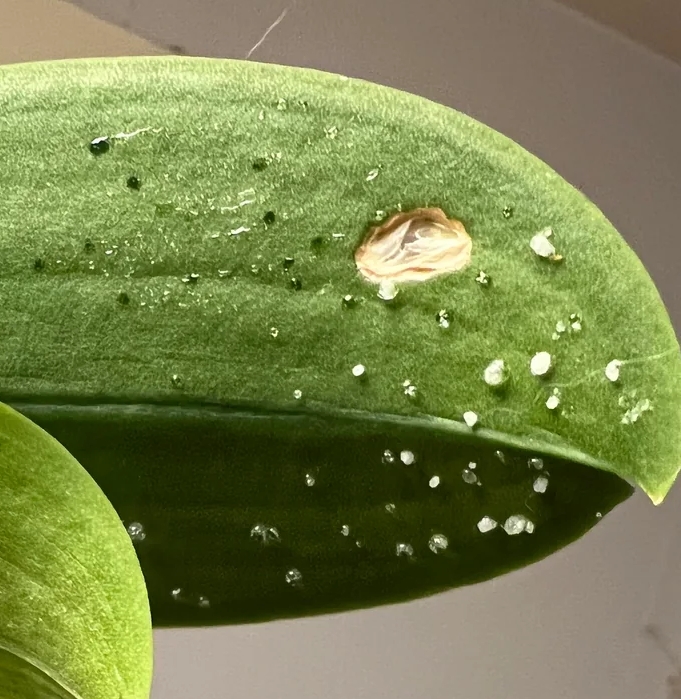
Disease: Scale or Aphids
Cause: Insect pests feeding on sap
Cure:
Sticky substances, or “honeydew,” signal the presence of scale insects or aphids. These bugs hide under the undersides and joints of leaves. Dab the bugs directly with a cotton swab dipped in rubbing alcohol. Follow up with neem oil sprays. Check nearby plants, as these pests move fast and can infest your entire collection if left unchecked.
Why Are My Orchid’s Buds Dropping Prematurely?
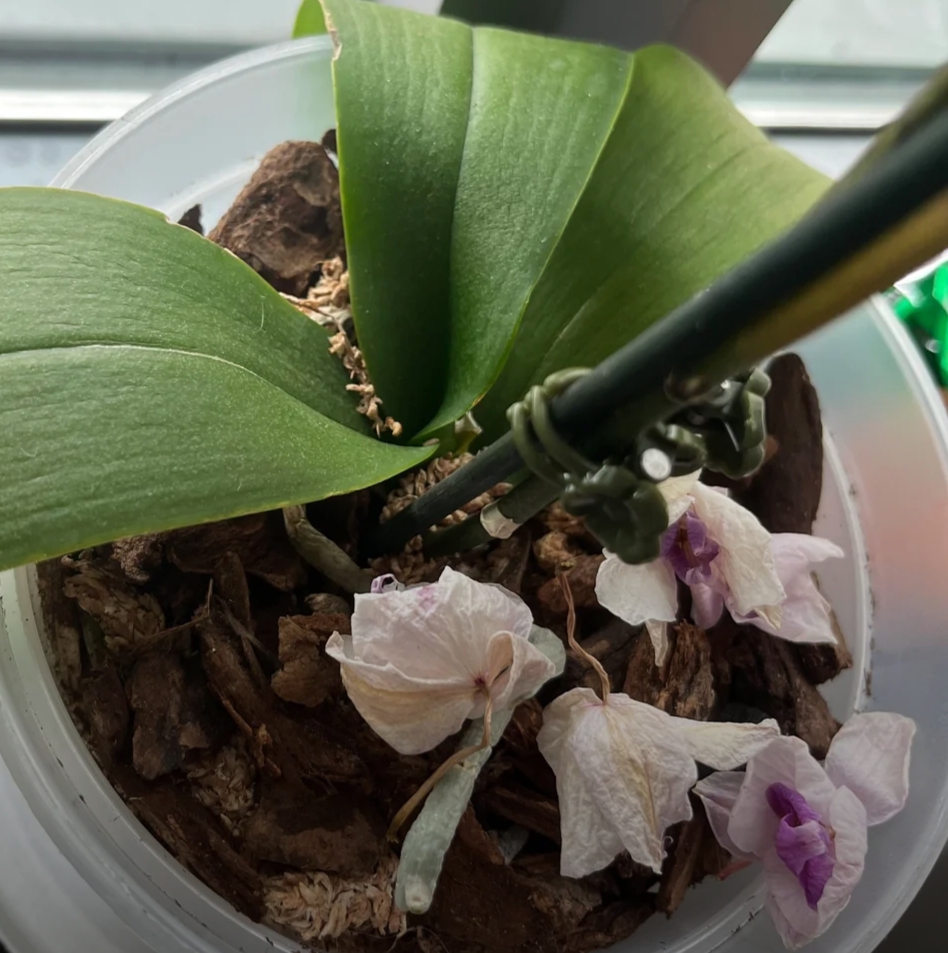
Disease: Bud Blast
Cause: Sudden changes in temperature, light, or humidity
Cure:
Bud blast happens when flower buds drop off before blooming, usually from environmental stress. Avoid moving the plant, especially during blooming. Keep temperature, humidity, and lighting conditions stable. Water consistently and avoid drafts. Adding a humidity tray or using a humidifier can also help prevent bud blast in dry indoor environments.
What’s Causing Brown Spots on My Orchid Leaves?
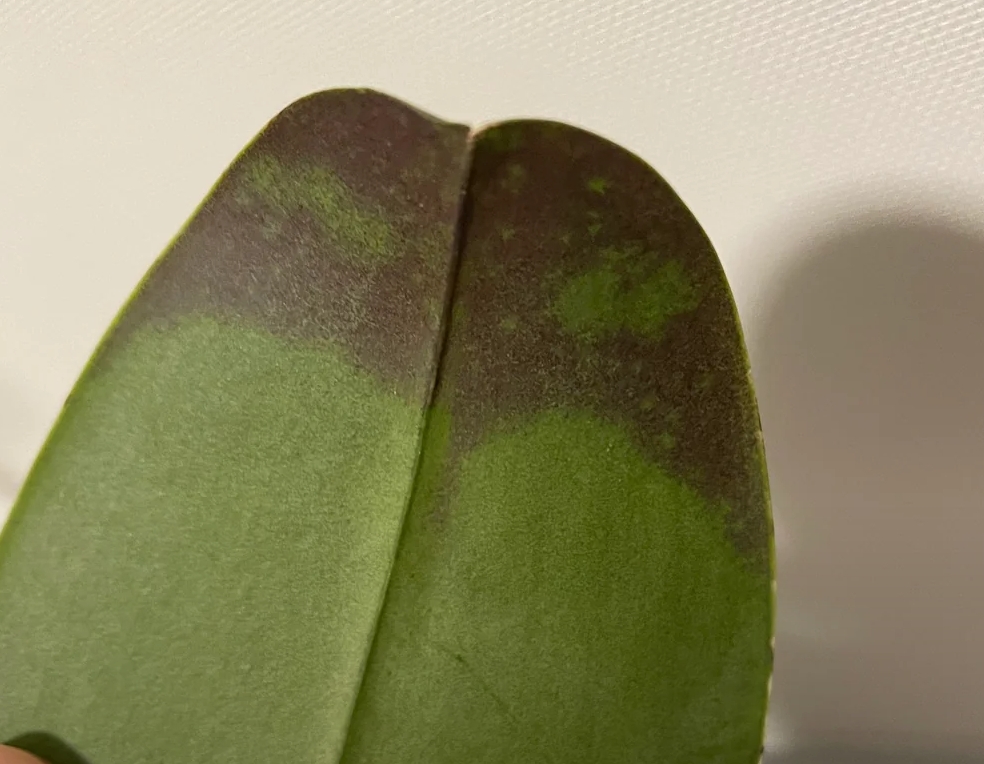
Disease: Sunburn or Bacterial Brown Spot
Cause: Direct sunlight or bacterial entry through wounds
Cure:
Brown, dry spots on leaves may be due to too much direct sunlight or bacterial infection.Place your orchid in an area that receives plenty of indirect light. If the spots are soft or ooze, they’re likely bacterial. Cut out affected tissue and apply bactericide. To avoid moisture accumulation on leaves, water in the morning and at the base.
Why Are There White Fluffy Patches on My Orchid?
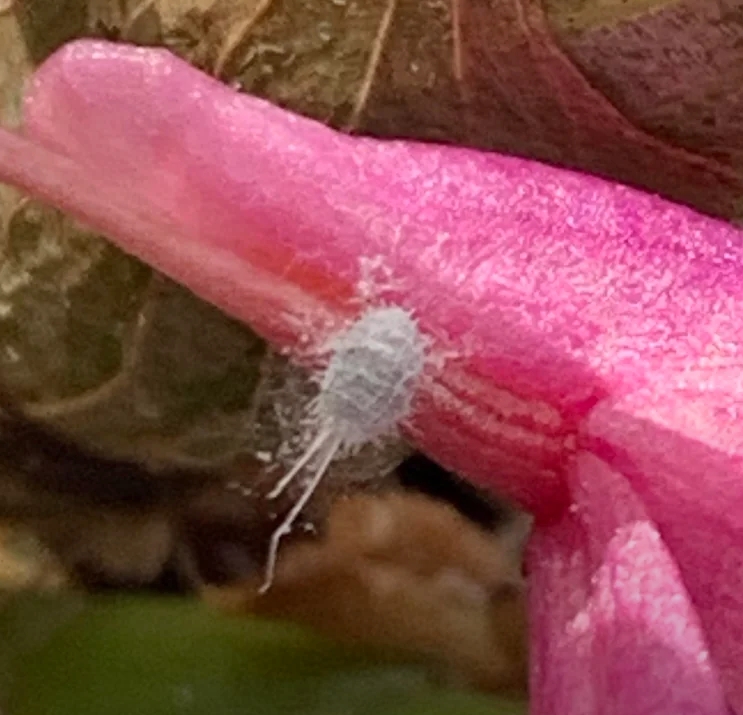
Disease: Mealybugs
Cause: Stagnant air and sweet plant sap attract pests
Cure:
Mealybugs gather in the joints and roots of leaves and resemble cotton balls.Gently brush or dab them away with a cotton swab dipped in alcohol. Spray neem oil weekly for a month to eliminate all life stages. Improving airflow, wiping leaves regularly, and quarantining new plants can prevent reinfestation.
What’s This Mushy Brown Area at the Base of My Orchid?
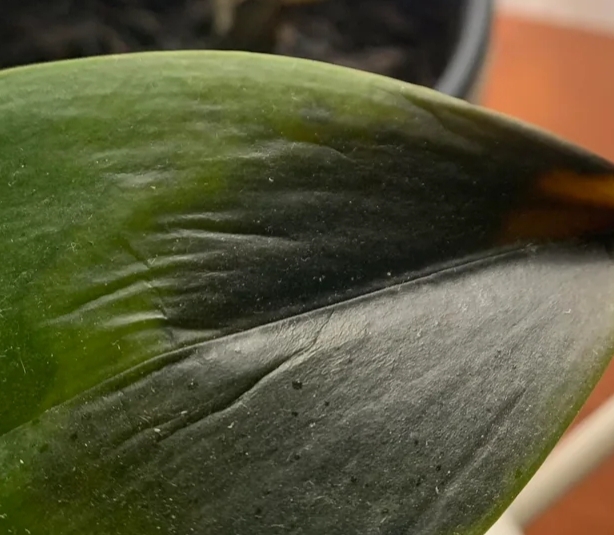
Disease: Crown Rot
Cause: Water pooling in the leaf crown
Cure:
Crown rot can kill orchids quickly if untreated. It starts with a soft, brown center where the leaves meet. Use sterile scissors to remove rotted tissue and tilt the orchid to dry the crown area completely. Apply hydrogen peroxide or a fungicide. Always water in the morning and avoid getting water in the crown when possible.
Final Tips to Keep Your Orchid Thriving
Healthy orchids need a balanced mix of light, water, air, and nutrients. The key to preventing diseases is maintaining proper care routines and spotting issues early. Always use sterilized tools, avoid overwatering, and inspect your orchids weekly for pests or signs of infection. With attention and care, your orchids can flourish and bloom beautifully for years to come.
FAQs – Is Your Orchid Sick
How can I tell if my orchid is sick?
Is your orchid sick and showing signs of distress? Yellowing leaves, black spots, wilting flowers, or soft roots are all symptoms of a problem. Carefully inspect your orchid’s overall appearance to determine whether it’s suffering from disease, pests, or environmental issues like poor lighting or overwatering.
2.What symptoms indicate orchid root rot?
Is your orchid sick because of root rot? Root rot is a common issue caused by excess moisture. If the roots are brown, mushy, and foul-smelling instead of firm and green or white, it’s likely your orchid is affected and needs immediate attention to prevent further damage.
Can overwatering cause orchid sickness?
Yes, overwatering is a major factor in orchid health decline. Is your orchid sick from sitting in soggy soil? Excessive water suffocates the roots, leading to fungal diseases and decay. Always let the growing medium dry slightly between waterings and make sure the pot has good drainage.
Why are my orchid’s leaves turning yellow?
Is your orchid sick if its leaves are turning yellow? Yellowing can result from excessive sunlight, root problems, nutrient deficiencies, or natural aging. Evaluate your care routine, including light exposure and watering frequency, to ensure your orchid is receiving the conditions it needs to thrive.
How do I revive a sick orchid?
Is your orchid sick and in decline? To help it recover, trim off any dead roots, repot it in fresh, well-draining media, reduce watering, and move it to a spot with bright, indirect light. Consistent care and a stable environment can work wonders for a struggling orchid.
What pests make orchids sick?
Do bugs have your orchid sick? Orchids can suffer significant harm from common invaders such as mealybugs, spider mites, and scale insects. Indicators include discoloured patches, white fluff, or sticky residue. To safely and successfully remove them, use rubbing alcohol, insecticidal soap, or neem oil
Should I prune my orchid if it’s sick?
Is your orchid sick with blackened or dead leaves? Pruning is essential in such cases. Cut off the infected or dying parts using sterilized scissors to stop the spread of disease. Always make clean cuts and avoid damaging healthy tissue to give your orchid a better chance of recovery.
Can lack of humidity make orchids sick?
Is your orchid sick from dry indoor air? Many orchid species, especially tropical ones, need humidity levels between 50–70%. Dry conditions can lead to shriveled leaves and stalled growth. You can improve humidity by misting the plant, using a humidifier, or placing it near a humidity tray.
How often should I check my orchid’s health?
Is your orchid sick or showing early symptoms? A weekly check helps detect problems before they worsen. Look closely at the roots, leaves, and stems for pests, rot, or discoloration. This habit helps you catch diseases early, leading to quicker recovery and better long-term plant health.
What is the black rot in orchids?
Is your orchid sick with black rot? This fungal disease causes black, mushy patches on leaves and roots. It spreads quickly in warm, damp conditions. Remove affected parts immediately and treat the rest of the plant with a fungicide to protect healthy tissue and stop further infection.
Is it normal for orchids to drop flowers?
Is your orchid sick if it drops its flowers suddenly? Not always—orchids naturally shed blooms after flowering. However, premature flower drop may indicate shock, dehydration, or disease. Review recent changes in temperature, watering, or light to determine the cause and stabilize the plant’s environment quickly.
Can a sick orchid still bloom?
Is your orchid sick yet still producing flowers? It’s possible, but the blooms might be smaller or short-lived. A stressed orchid may prioritize survival over flowering. Focus on restoring overall plant health through proper watering, repotting, and feeding so future blooms are vibrant and long-lasting.
Should I repot a sick orchid immediately?
Is your orchid sick and still in old or soggy potting medium? Repotting can give it a fresh start. Remove all rotted roots, trim damaged areas, and place the orchid in a clean pot with fresh bark or sphagnum moss. Proper air circulation and drainage are crucial during recovery.
Can sick orchids recover fully?
Is your orchid sick and beyond help? Not necessarily. Orchids are resilient plants. With patience, correct diagnosis, and attentive care, most sick orchids can bounce back. Focus on improving light, water, and airflow conditions. Keep a consistent care schedule and avoid stressors to promote healing and new growth.
